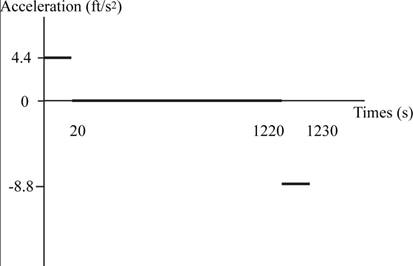
Concept explainers
Calculate the total distance traveled by the car and the average speed of the car. Plot the acceleration of car as a function of time.
Answer to Problem 28P
The total distance traveled by car is
Explanation of Solution
Refer to the figure Problem 8.28 in the textbook for the speed versus time characteristics of the car.
During the initial 20 seconds, the speed of the car increases linearly from a value of zero to 60 mph. Therefore, the average speed of the car is 30 mph during this period. The distance traveled during this period is,
During the next 20 minutes the car moves with a constant speed of 60 mph and the distance traveled during this period is,
Because the car decelerates at a constant rate from a speed of 60 mph to 0 mph, the average speed of the car during the last 10 seconds is also 30 mph, and the distance traveled during this period is,
The total distance traveled is
Substitute 880 feet for
Give the expression for average speed of the car for the entire duration of travel as below.
Substitute
To plot the acceleration of car as a function of time, calculate the acceleration during the first 20 seconds, the next 20 minutes, and the last 10 seconds.
Calculate the acceleration of the car during the initial 20 seconds as below.
Note during this 20 seconds period, the speed of car changes from 0 to
During the next 20 minutes, the car moves with constant speed of 60 mph. Therefore, the acceleration is zero.
Show the plot of acceleration versus time as in Figure 1.

Conclusion:
Thus, the total distance traveled by car is
Want to see more full solutions like this?
Chapter 8 Solutions
Engineering Fundamentals: An Introduction to Engineering (MindTap Course List)
- How many steel studs are needed in total ? (Exterior walls are exsisting) Studs are spaced 16” OC Add 2 studs x each door & intersection How many 4 x 8 drywall sheets are required if walls are 8 ft high Exterior walls only need drywall on interior side Interior walls need drywall on both sides Show all workarrow_forwardanswer on paper and make sure work is done step by step correctly and neatlyarrow_forwardEx 11: Design inlet system for the road in figure below with catchment area=86 m*239 m. C=0.8, i=100 mm/hr, Gutter data: y max.=8cm, n=0.018, k=0.38, slope=%1, Z=25, %25 clogging, (space=bar=2 cm). Inlet type used (consists of tow part curb and Q grad inlet =0.6Qgutter max. grade inlet) Q curb inlet =0.4Qgutter max. 0.8*100 3600*1000 Solution: (Qs) Total=CIA= Qgutter (Max.)=k²√√s y8/3 = 0.38- 25 0.018 *(86*239)=0.457 m³/s √0.01 0.088/3= 0.0627 m³/s 30 m 12 m 2mL 12 m 30 m Residence 30 m Streat 12 m Bof 2 m ㅈ 239 m A2 A1arrow_forward
- (20 02 A concrete beam of rectangular cross-section (300 x 400) mm is Prestressed with wires located at (30) mm from the top of the beam .The wires are initially tensioned to 0-6 mm) diameter wires at (100) mm from the soffit of the beam and (5-6 mm) a stress of (900 N/mm²). Compute the percentage loss of stress in steel after transfer due to elastic deformation of concrete. Given: Es=200 x 103 N/mm², Ec = 25 x 10³ N/mm². 300 за 60000 400 100 546 2046arrow_forwardReinforced Concrete Design First Monthly Exam 24/02/2 Q1. A simply supported rectangular beam (300 x 400) mm and span (12) m with live load of from the soffit of the beam. Compute the stresses at mid-span of beam for the following (5 kN/m). At the centre of the beam the prestressing force of (120) kN is located at (50 mm) conditions: (a) Prestress + self- weight of beam (initial stage). (b) Prestress + self- weight of beam + Live Load (service stage). 3:00 400 120 K * 12m 5kN/m. 120 KNarrow_forwardA driven pipe pile in clay is shown in Figure (1). The pipe has outside diameter of 406 mm, and wall thickness is 6.35 mm. a. calculate the net point bearing capacity. b. calculate the skin resistance (1) by using a method, (2) by using A method. e. Estimate the net allowable pile capacity. Use FS-4. Figure (1) 5 m Saturated clay 30 kN/m² Groundwater table y= 18 kN/m 5 m Clay C-30 kN/m2 y= 18 kN/m 20 m C Clay -100 kN/m² 19.6 kN/marrow_forward
- A fully embeded precast, prestressed concrete pile is 12 m long and is driven into homogeneous layer of sand. The pile is square in cross section, with sides measuring 305 mm. The dry unit weight of sand is 16.8 kN/m, and the average effective soil friction angle is 35°. The allowable working load is 338 kN. If 240 kN is contributed by the frictional resistance and 98 kN is from the point load, determine the elastic settlement of the pile. Use Ep 21 x 10 kN/m², E, 30000 kN/m², and μ-0.3.arrow_forwardA 15 in. x 26 in. rectangular RC beam (shown in figure below) supports a service uniform deadload of 1.3 kip/ft and a service uniform live load of 1.6 kip/ft. The dead load includes the beam’sself-weight. Design the reinforcement required for maximum moments and show the design insketches. Use f c ’ = 4,000 psi and f y = 60,000 psi. The beam is used in an open parking garage andis exposed to weather.a. Find factored maximum bending moments.b. Design for max. negative moment.c. Design for max. positive moment.Hint: Assume an initial beam shape (b, d), then solve for the needed reinforcements at the maximumnegative and positive factored bending momearrow_forwardA structure is an intersecting hip roof with the main hip roof outside dimensions being 73 ft long and the width being 30 ft wide. The intersection portion extends 20 ft beyond the 30-ft side, and the intersecting portion is 20 ft wide. The overhang is 2 ft 6 in. and the slope is 5:12. The rafters are 16 in. on center. Based on the information provided, what is the total length of the common rafters in linear feet?arrow_forward
- How many board feet is 200 lnft of 2 in. × 6 in wood studs.arrow_forwardExample: Determine the minimum slope in the upper reach of a chute section of 30 m width. The range of discharge is 150 to 2000 m³/sec. n = 0.015.arrow_forward1. Zinc is an important trace nutrient for photosynthetic organisms (e.g., phytoplankton) in sea water. Calculate the speciation of zinc (Zn(II)) in seawater assuming Zn(II) TOT = 5 x 10-8 M. Provide a list of the metal-ligand complexes and their corresponding stability Constants that you will include in your calculation. If you decide to exclude any of the complexes for which stability constants are provided in Table 9.4, please list these separately and explain your rationale. b. Compute the concentrations of the metal-ligand complexes identified in part a. c. Compute the activities of the metal-ligand complexes using the concentrations calculated in part b and using the data in Table 9.6B to calculate the activity coefficients. (Note—you likely already have a spreadsheet where you calculated activity coefficients from week 3!)arrow_forward
 Engineering Fundamentals: An Introduction to Engi...Civil EngineeringISBN:9781305084766Author:Saeed MoaveniPublisher:Cengage Learning
Engineering Fundamentals: An Introduction to Engi...Civil EngineeringISBN:9781305084766Author:Saeed MoaveniPublisher:Cengage Learning Traffic and Highway EngineeringCivil EngineeringISBN:9781305156241Author:Garber, Nicholas J.Publisher:Cengage Learning
Traffic and Highway EngineeringCivil EngineeringISBN:9781305156241Author:Garber, Nicholas J.Publisher:Cengage Learning


